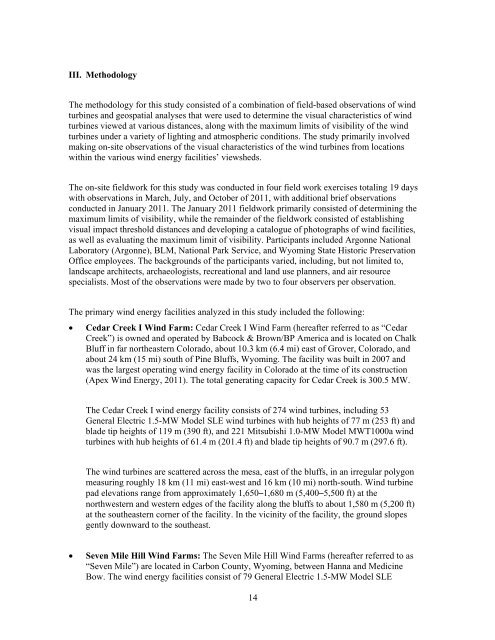Wind Turbine Visibility and Visual Impact Threshold Distances in ...
Wind Turbine Visibility and Visual Impact Threshold Distances in ...
Wind Turbine Visibility and Visual Impact Threshold Distances in ...
Create successful ePaper yourself
Turn your PDF publications into a flip-book with our unique Google optimized e-Paper software.
III. Methodology<br />
The methodology for this study consisted of a comb<strong>in</strong>ation of field-based observations of w<strong>in</strong>d<br />
turb<strong>in</strong>es <strong>and</strong> geospatial analyses that were used to determ<strong>in</strong>e the visual characteristics of w<strong>in</strong>d<br />
turb<strong>in</strong>es viewed at various distances, along with the maximum limits of visibility of the w<strong>in</strong>d<br />
turb<strong>in</strong>es under a variety of light<strong>in</strong>g <strong>and</strong> atmospheric conditions. The study primarily <strong>in</strong>volved<br />
mak<strong>in</strong>g on-site observations of the visual characteristics of the w<strong>in</strong>d turb<strong>in</strong>es from locations<br />
with<strong>in</strong> the various w<strong>in</strong>d energy facilities’ viewsheds.<br />
The on-site fieldwork for this study was conducted <strong>in</strong> four field work exercises total<strong>in</strong>g 19 days<br />
with observations <strong>in</strong> March, July, <strong>and</strong> October of 2011, with additional brief observations<br />
conducted <strong>in</strong> January 2011. The January 2011 fieldwork primarily consisted of determ<strong>in</strong><strong>in</strong>g the<br />
maximum limits of visibility, while the rema<strong>in</strong>der of the fieldwork consisted of establish<strong>in</strong>g<br />
visual impact threshold distances <strong>and</strong> develop<strong>in</strong>g a catalogue of photographs of w<strong>in</strong>d facilities,<br />
as well as evaluat<strong>in</strong>g the maximum limit of visibility. Participants <strong>in</strong>cluded Argonne National<br />
Laboratory (Argonne), BLM, National Park Service, <strong>and</strong> Wyom<strong>in</strong>g State Historic Preservation<br />
Office employees. The backgrounds of the participants varied, <strong>in</strong>clud<strong>in</strong>g, but not limited to,<br />
l<strong>and</strong>scape architects, archaeologists, recreational <strong>and</strong> l<strong>and</strong> use planners, <strong>and</strong> air resource<br />
specialists. Most of the observations were made by two to four observers per observation.<br />
The primary w<strong>in</strong>d energy facilities analyzed <strong>in</strong> this study <strong>in</strong>cluded the follow<strong>in</strong>g:<br />
Cedar Creek I <strong>W<strong>in</strong>d</strong> Farm: Cedar Creek I <strong>W<strong>in</strong>d</strong> Farm (hereafter referred to as “Cedar<br />
Creek”) is owned <strong>and</strong> operated by Babcock & Brown/BP America <strong>and</strong> is located on Chalk<br />
Bluff <strong>in</strong> far northeastern Colorado, about 10.3 km (6.4 mi) east of Grover, Colorado, <strong>and</strong><br />
about 24 km (15 mi) south of P<strong>in</strong>e Bluffs, Wyom<strong>in</strong>g. The facility was built <strong>in</strong> 2007 <strong>and</strong><br />
was the largest operat<strong>in</strong>g w<strong>in</strong>d energy facility <strong>in</strong> Colorado at the time of its construction<br />
(Apex <strong>W<strong>in</strong>d</strong> Energy, 2011). The total generat<strong>in</strong>g capacity for Cedar Creek is 300.5 MW.<br />
The Cedar Creek I w<strong>in</strong>d energy facility consists of 274 w<strong>in</strong>d turb<strong>in</strong>es, <strong>in</strong>clud<strong>in</strong>g 53<br />
General Electric 1.5-MW Model SLE w<strong>in</strong>d turb<strong>in</strong>es with hub heights of 77 m (253 ft) <strong>and</strong><br />
blade tip heights of 119 m (390 ft), <strong>and</strong> 221 Mitsubishi 1.0-MW Model MWT1000a w<strong>in</strong>d<br />
turb<strong>in</strong>es with hub heights of 61.4 m (201.4 ft) <strong>and</strong> blade tip heights of 90.7 m (297.6 ft).<br />
The w<strong>in</strong>d turb<strong>in</strong>es are scattered across the mesa, east of the bluffs, <strong>in</strong> an irregular polygon<br />
measur<strong>in</strong>g roughly 18 km (11 mi) east-west <strong>and</strong> 16 km (10 mi) north-south. <strong>W<strong>in</strong>d</strong> turb<strong>in</strong>e<br />
pad elevations range from approximately 1,650–1,680 m (5,400–5,500 ft) at the<br />
northwestern <strong>and</strong> western edges of the facility along the bluffs to about 1,580 m (5,200 ft)<br />
at the southeastern corner of the facility. In the vic<strong>in</strong>ity of the facility, the ground slopes<br />
gently downward to the southeast.<br />
Seven Mile Hill <strong>W<strong>in</strong>d</strong> Farms: The Seven Mile Hill <strong>W<strong>in</strong>d</strong> Farms (hereafter referred to as<br />
“Seven Mile”) are located <strong>in</strong> Carbon County, Wyom<strong>in</strong>g, between Hanna <strong>and</strong> Medic<strong>in</strong>e<br />
Bow. The w<strong>in</strong>d energy facilities consist of 79 General Electric 1.5-MW Model SLE<br />
14


